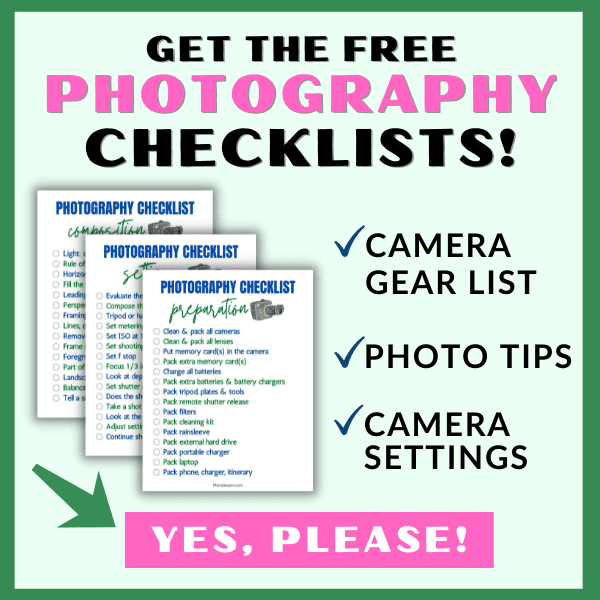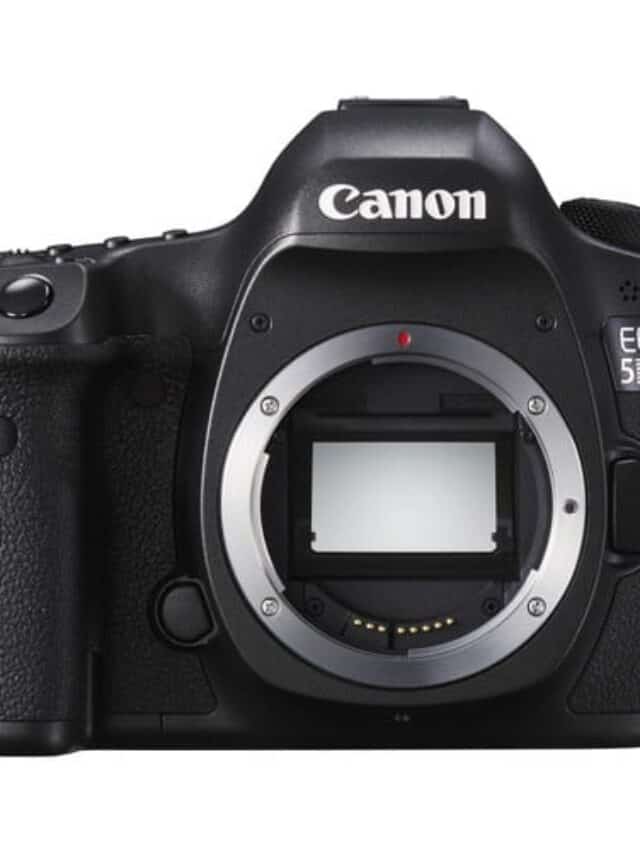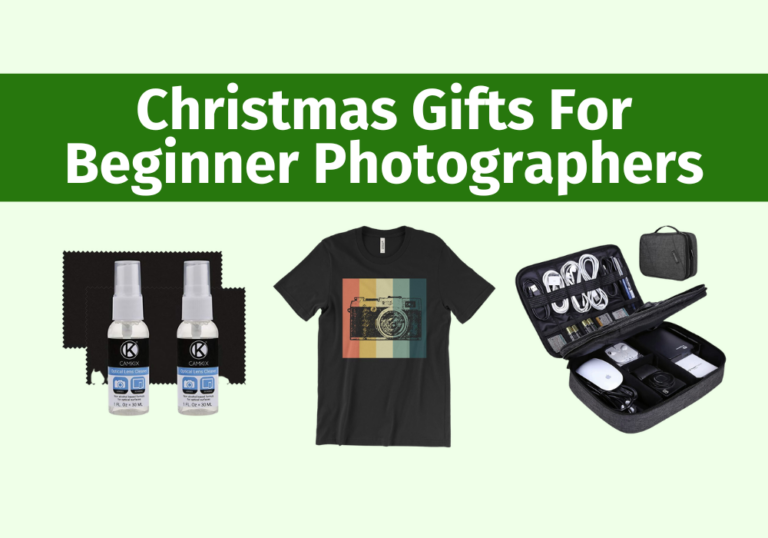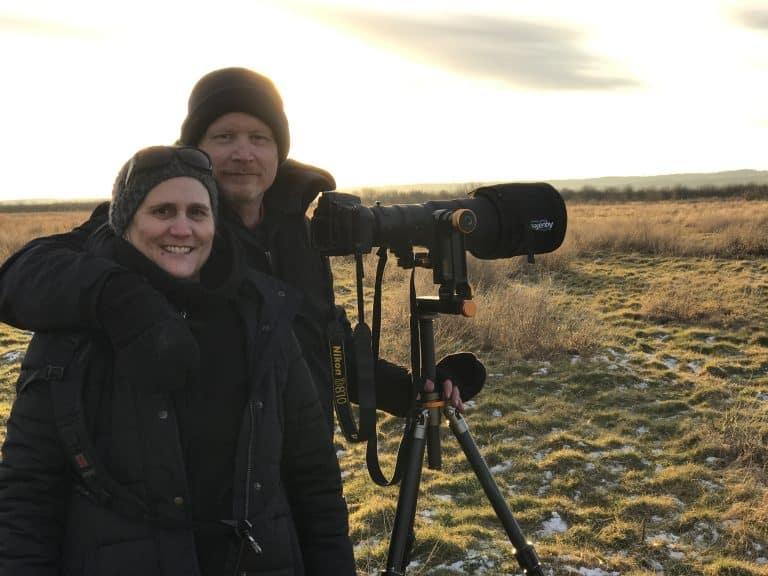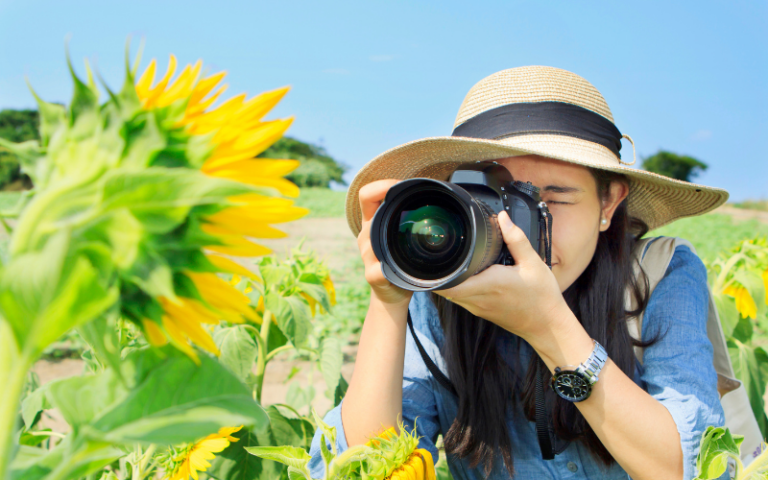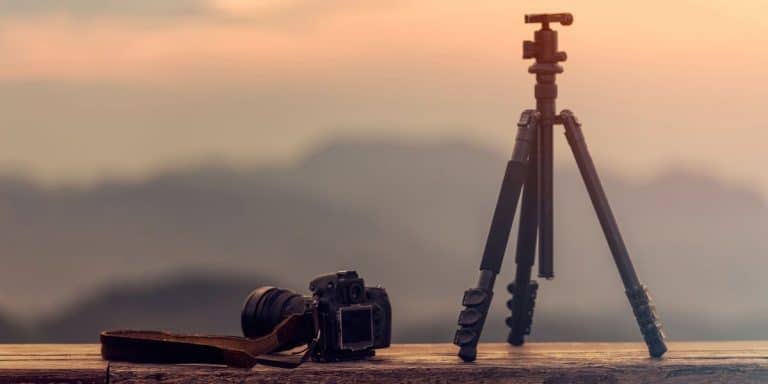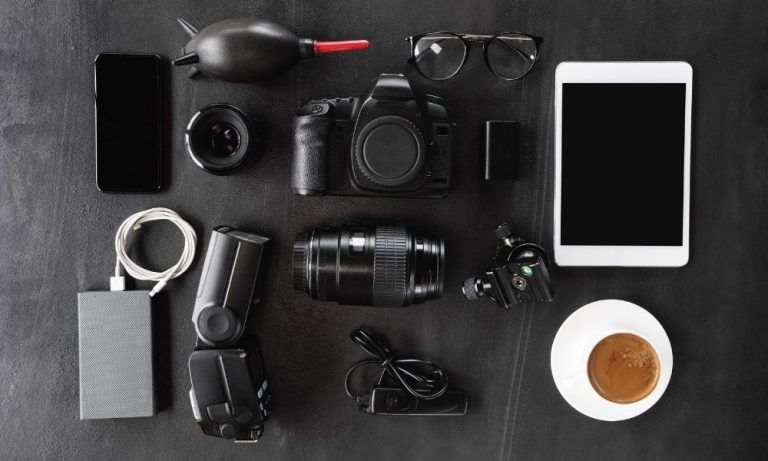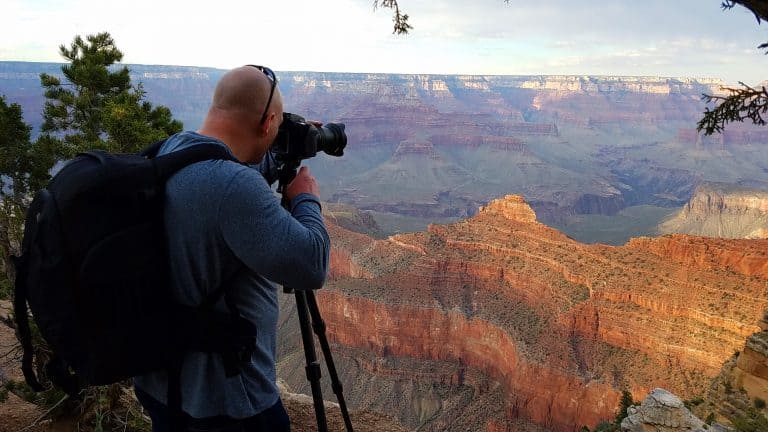Best DSLR Cameras for Travel Photography
Why would we recommend DSLR cameras for travel photography when some mirrorless cameras are more powerful, compact, and lighter?
Before you add any camera to your travel photography gear, be sure to try out each type of camera to find the best choice for your needs.
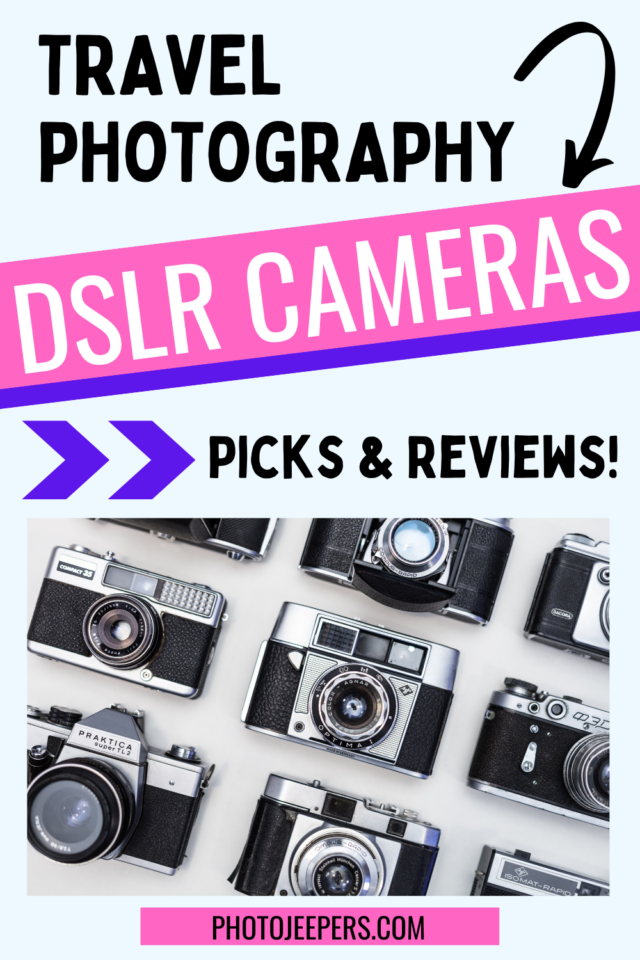
DSLR cameras still include a wider selection of lenses, generally better optical viewfinders (looking straight through the lens could be the decisive factor for some photographers), much better battery life as well as heft and stability in hand.
In this guide we share information about how to choose a good DSLR camera, the DSLR travel cameras we recommend, and how to pick the perfect lens for your travel photography camera.
This site contains affiliate links which means WE may receive commissions for purchases made through these links. We only provide links to products we actually use and/or wholeheartedly recommend! As an Amazon Associate, we earn from qualifying purchases. Read the full Disclosure Policy.
How to Choose the Best DSLR Camera for Travel
The process of shopping for a DSLR camera can be confusing and overwhelming. To help you out, we have compiled the essential features that you should consider when comparing different DSLR camera models.
1. Sensor Size
The sensor is arguably the most important part of a camera. It’s the component that captures light and transforms it into an image. As such, it plays a huge role in affecting how the digital image file will look.
The size of the sensor directly affects the camera’s performance. When using the camera for low-light or night photography, a large sensor will capture more light thereby producing more pleasing images.
A large sensor also has the advantage of allowing for greater depth of field (DoF) effects. Remember, DoF is a really important tool in travel photography because it allows you to isolate the subject from the background.
Usually, a larger sensor means the camera body will also need to be larger to house it. The larger DSLR cameras can accommodate larger lenses, and they have a faster processor and autofocus system which means these cameras may be pricey!
The heavier and bulkier design of these cameras is the trade-off you’ll have to make for their better performance and superior imaging capabilities. When it comes to DSLRs, there are mainly two types of sensor sizes that you will encounter, Full-Frame and APS-C.
Full-Frame Sensors
Full-Frame (FX-format) sensor is the largest sensor size available in DSLRs. They are called Full-Frame because they match the size of the piece of film found in the traditional film SLR cameras, which measures 36mm x 24mm.
A Full-Frame sensor is capable of capturing more light, which makes it ideal for low-light photography. Cameras with Full-Frame sensors best suit professionals and enthusiast photographers who perform a lot of cropping and editing in post-processing.
APS-C Sensors or Crop Sensors
A Crop Sensor is anything smaller than 36mm x 24mm. It’s called the crop sensor because you’re effectively cropping the full-frame image.
They are cheaper to manufacture, so they can be found in most consumer DSLRs.
In our above list of the best DSLR cameras for travel photography, we have featured entry-level and mid-range crop sensor DSLRs that will perfectly suit beginners to enthusiast photographers who are looking to capture high-resolution photos without breaking the bank.
2. Optical Viewfinder (OVF)
An optical viewfinder is the part of a DSLR that you put one eye up to the camera and look through, to preview the scene. The main advantage of OVF is that you see what the camera lens sees since you look through the lens. DSLRs have OVF, while mirrorless cameras have EVF (Electronic Viewfinder).
Unlike OVF, EVF doesn’t show you a view of the scene through the lens. Rather, it shows you what the camera sensor sees. And because the sensor is a little screen inside the camera, you will be looking at a processed scene. instead of a straightforward view of the “real” scene.
OVFs offer better picture quality compared to EVF since you’re always seeing a true image of the scene. Moreover, unlike EVFs, OVFs have zero energy consumption and are always on. That means you can look through your camera’s optical viewfinder at any time, even if it’s powered OFF.
TIP: Since optical viewfinders don’t drain the battery, you get an extended battery life when you go for a DSLR. That explains why most of the cameras above have an impressive battery life. DSLRs are also larger in size compared to mirrorless and compact cameras, something that allows them to accommodate larger batteries.
3. Manual Mode
Apart from the sensor size and optical viewfinder, the next important reason for getting a DSLR over other cameras is the manual mode. DSLRs are designed for users who want full control over their photography. As such, they come with fully manual controls for manual mode photography.
When taking a photo with a DSLR, you can either choose the Auto Mode or Manual Mode. In the Auto mode, the camera will auto-select the best settings for taking the photo depending on the environment. In Manual Mode, you manually adjust these settings with dials and buttons.
The three important settings in manual mode photography are Aperture, Shutter Speed, and ISO. The trio alters the camera’s sensor exposure to light. Understanding the manual mode will help you get more creative with your photography by shooting photos with bokeh, silhouettes, and so on.
4. Megapixels (MP)
Most camera manufacturers use megapixel rating as marketing material. And as a shopper, it’s very easy to fall for an average camera model with high megapixels. But you most likely don’t need a DSLR with higher megapixels for your travel photography.
Megapixels simply refers to one million pixels. It is the unit used to measure the resolution of digital cameras. More pixels usually mean more detail in an image. For example, a 12MP camera will capture an image of 4,000 pixels wide and 3,000 pixels high (4000 times 3,000 = 12 million pixels = 12MP).
NOTE: As a general rule, megapixels are important if you are planning to print your work or do a lot of cropping in post-processing. If your travel photos will be viewed and used on social media, websites, blogs, emails, digital photo galleries, and screensavers, then you don’t need to worry about getting the highest MP camera. For the average traveller, an 8MP to 12MP image resolution is perfectly fine for your uses!
5. Image Burst Rate
Burst rate refers to the number of images the camera can capture in a sequence if you hold down the shutter button. Normally, the burst rate is given in frames per second (FPS), where one frame is one image. So, FPS represents the number of images captured in one second.
A camera’s burst rate is especially useful in action and wildlife photography. The higher the number, the better!
6. Image Stabilization
Sometimes it’s inevitable that you’ll need to take photos while holding the camera with your hand, instead of putting your camera on a tripod. Handheld shooting can result in blurry photos if there is insufficient light in your shooting environment.
The photos end up blurred since as humans we are unable to hold our hands entirely still. As such, the camera ends up shaking due to the small hand movements. The best way to avoid such camera shakes is to invest in a good tripod. But in some cases, it may not be practical to use a tripod.
Getting a camera with in-body image stabilization can help! The image stabilization will offset the small camera shakes due to your hand movements, especially when shooting at slower shutter speeds. There are lenses with image stabilization as well.
TIP: But we will always recommend a good lightweight travel tripod to get those tack sharp images!
7. Video Recording Features
As a general rule, a good photography camera will always record decent video footage. All of the cameras above record at least Full HD 1080p videos at 30fps. This footage is clear and smooth enough to appeal to most consumer video platforms like YouTube.
If you double as a vlogger, you should consider the camera’s video resolution, frame rate, and audio capabilities. A 1080p video resolution is perfect, but having the ability to record in 4K is a plus! Frame rate (fps) is the number of individual video frames/images captured by the camera per second.
NOTE: Video footage is a sequence of images that move at such a faster rate that your eyes perceive motion. Hence, a frame rate of 30fps means more images per second than 24fps. At 1080p and 60fps, the video footage is very smooth. A higher frame rate like 120fps is great for slow-motion playback.
When it comes to vlogging, nothing turns off an audience like good video footage with poor audio. We recommend getting a camera with at least a built-in stereo mic. But if you’re a vlogging enthusiast, consider a DSLR that offers an option to plug-in an external mic.
8. Camera Body
To niche down further on your ideal DSLR camera for travel photography, you need to consider the camera body components: weather-sealing, the material used to make the chassis, weight, and size.
Weather sealing is usually found in more premium DSLRs that are designed for professionals and enthusiasts. Such cameras will have a weather-sealing for moisture and dust, while some have waterproofing. With a weather-sealing, you will have peace of mind when doing your photography in extreme environments.
Usually, weather-sealed cameras are designed with a robust body made of magnesium-alloy or aluminum chassis. But you will need to pay more to enjoy their premium design.
Further, you also need to consider the camera weight and size. DSLRs are normally heavier and bulkier than mirrorless and compact cameras. Mainly because they have a mirror(s) and a large sensor inside the camera body.
9. Lens Availability
When you buy a DSLR camera, especially Nikon or Canon, you’ll have a wide selection of compatible lenses. The lens options also include some third party manufacturers like Sigma, which can accommodate the two brands.
TIP: If you’re just a beginner, we always recommend starting out with the kit lenses that come with the cameras. Later, you can upgrade to a versatile lens depending on the type of travel photography you pursue.
10. Other Features
Among the other features that you will want to consider include connectivity, external mic input, LCD screen, battery life, GPS, and a headphone jack. Your ideal camera should at least have built-in WiFi connectivity. Having Bluetooth, NFC, and HDMI is a plus. Almost all of the DSLRs above have WiFi and HDMI connectivity.
Apart from connectivity, a DSLR with an articulating touchscreen LCD will usually provide you with the best photography experience. An articulating screen allows you to capture photos and videos from different angles without changing your position. With a flip-screen, you can easily take selfie shots and videos.
With a responsive, intuitive touch-enabled LCD, controlling the camera gets easier! Other additional features like GPS for geotagging your photos and a longer-battery life are always a plus. Keep in mind that you can always pack extra batteries or a power bank just in case your travels involve visiting remote locations.
Best DSLR Cameras for Travel Photography

Canon EOS 6D Mark II DSLR Camera
Key Features
- 26.2MP Full-Frame CMOS Sensor
- DIGIC 7 Image Processor
- 45-Point All-Cross Type AF System
- Full HD Video at 60 fps; Digital IS
- 3" 1.04m-Dot Vari-Angle Touchscreen LCD
- Dual Pixel CMOS AF and Movie Servo AF
- Native ISO 40000, Expanded to ISO 102400
- 6.5 fps Shooting; Time-Lapse & HDR Movie
- Built-In GPS, Bluetooth & Wi-Fi with NFC
- Dust and Water-Resistant; SD Card Slot

Nikon D850 DSLR Camera
Key Features
- 45.7MP FX-Format BSI CMOS Sensor
- EXPEED 5 Image Processor
- 3.2" 2.36m-Dot Tilting Touchscreen LCD
- 4K UHD Video Recording at 30 fps
- Multi-CAM 20K 153-Point AF System
- Native ISO: 64-25600,Extended: 32-102400
- 7 fps Shooting for 51 Frames with AE/AF
- 8K Time-Lapse, Negative Digitizer Mode
- 180k-Pixel RGB Sensor, Focus Shift Mode
- SnapBridge Bluetooth and Wi-Fi

Canon EOS 5D Mark IV DSLR Camera
Key Features
- 30.4MP Full-Frame CMOS Sensor
- DIGIC 6+ Image Processor
- 3.2" 1.62m-Dot Touchscreen LCD Monitor
- DCI 4K Video at 30 fps; 8.8MP Still Grab
- 61-Point High Density Reticular AF
- Native ISO 32000, Expanded to ISO 102400
- Dual Pixel RAW; AF Area Select Button
- Dual Pixel CMOS AF and Movie Servo AF
- 7 fps Shooting; CF & SD Card Slots
- Built-In GPS and Wi-Fi with NFC

Canon EOS 90D DSLR Camera
Key Features
- 32.5MP APS-C CMOS Sensor
- DIGIC 8 Image Processor
- UHD 4K30p & Full HD 120p Video Recording
- 3" 1.04m-Dot Vari-Angle Touchscreen LCD
- 45-Point All Cross-Type AF System
- Dual Pixel CMOS AF with 5481 AF Points
- Up to 10-fps Shooting, ISO 100-25600
- Built-In Wi-Fi and Bluetooth
- EOS iTR AF, Electronic Shutter Function
- 220,000-Pixel AE Metering Sensor

Pentax K-70 DSLR Camera
Key Features
- 24.24MP APS-C CMOS Sensor
- PRIME MII Image Processor
- Anti-Aliasing Filter Simulator
- 3.0" 921k-Dot Vari-Angle LCD Monitor
- Full HD 1080i Video at 60 fps
- SAFOX X 11-Point AF with 9 Cross Sensors
- ISO 100-204800, Up to 6 fps Shooting
- Built-In Wi-Fi, Compatible with O-GPS1
- Shake Reduction & Pixel Shift Resolution
- Weather-Resistant Construction

Canon EOS Rebel SL3 DSLR Camera
Key Features
- 24.1MP APS-C CMOS Sensor
- DIGIC 8 Image Processor
- 3.0" 1.04m-Dot Vari-Angle Touchscreen
- UHD 4K24p Video and 4K Time-Lapse Movie
- 9-Point AF System; Dual Pixel CMOS AF
- ISO 100-25600, Up to 5 fps Shooting
- Built-In Wi-Fi and Bluetooth

Canon EOS Rebel T8i DSLR Camera
Key Features
- 24.1MP APS-C CMOS Sensor
- DIGIC 8 Image Processor
- 3.0" 1.04m-Dot Vari-Angle Touchscreen
- UHD 4K24p Video, Vertical Video Support
- 45-Point All Cross-Type Phase-Detect AF
- Dual Pixel CMOS AF with Eye Detection
- ISO 100-25600, Up to 7 fps Shooting
- Built-In Wi-Fi and Bluetooth
- 220,000-Pixel AE Sensor
How to Pick the Perfect Lens for Your DSLR Camera
After buying a DSLR camera, the next important piece of your travel photography gear is a lens. Some DSLR cameras come with a kit lens, meaning that you can take photos as soon as you assemble the camera and lens. But kit lenses have limitations in terms of their features and the image-quality that they can capture.
Investing in a good lens will allow you to capture sharp and detailed photos. One of the main advantages of DSLRs (and mirrorless) cameras is the fact that they work with interchangeable lenses. Something that allows you to invest in an assortment of lenses for different types of travel photography.
When buying a travel photography lens, it’s important to consider the types of subjects that you intend to shoot. This allows you to get a clue of the most likely lighting conditions that you’ll experience during your work. Different lens suits different situations. Usually, lenses fall into six main categories:
1. Standard Lenses
A standard lens, also known as a normal lens, has a fixed focal length that is usually around 50mm. A good 50mm prime lens normally reproduces fairly accurately what the human eye sees in terms of angle of view and perspective. It captures an image that appears “natural” to the viewer.
Standard lenses also have a wide aperture, something that gives them excellent low-light performance. If you’re ready for that next step to improve your photography, technically and creatively, then get a 50mm prime lens.
2. Zoom Lenses
As the name suggests, zoom lenses have a variable focal length. These lenses can be zoomed “in” and “out” to provide a wider range of focal lengths. As a result, they are usually extremely versatile and useful, making them the primary lens choice for most travel photography work.
Zoom lenses will normally have a focal length range that falls between 15mm (wide angle) and 300mm (telephoto). With a zoom lens, you can shoot dynamic landscapes or zoom into wildlife and action in far distances and capture then from afar. The only trade-off of a zoom lens is its limited aperture.
3. Telephoto Lenses
Telephoto lenses usually have a longer focal length range of between 100mm and 800mm. These lenses provide a high magnification level, thus allowing you to capture subjects at moderate to far distances. Their longer focal length range, however, makes them bigger and heavier than other types of lenses.
Modern tech-advances have allowed for more compact telephoto lenses. But such lenses are quite expensive! Telephoto lenses are generally ideal for sports and wildlife photography – where you can’t get near the subject. We only recommend them to professionals or as a secondary lens to enthusiasts.
Check out our list of the best lenses for wildlife photography!
4. Wide-Angle Lenses
A wide-angle lens is the opposite of a telephoto lens. They usually have a shorter focal length and provide an angle of view beyond that of normal lenses. As such, they are able to capture more of a scene in a single shot. Wide-angle lenses are therefore ideal for landscape and group portrait photography.
TIP: If you’re a budding landscape photographer, we recommend getting an affordable wide-angle lens with a focal length range of between 10mm and 42mm. Having such a lens along with a zoom lens will give you a good headstart as you go about documenting your travel adventures.
5. Macro Lenses
Macro lenses are specially designed for close-up photography. They are useful for capturing subjects like small animals, insects, and plants at a very close range. These lenses capture really eye-catching photos due to their special internal construction that gives them excellent sharpness and contrast.
6. Kit Lenses
We have mentioned “kit lenses” quite a bit in this guide. A kit lens is a lens that comes bundled with an entry-level or mid-range camera. They are usually “very cheap and slow” zoom lenses with average image quality. But they are great for getting you up and running quickly as you learn around a DSLR.
TIP: If you are past the beginner stage, then we recommend you purchase the camera body and the specific lenses that produce the image you want to capture.
Tips for Buying a Zoom Lens for Your Travel Photography
As you might have noted, your first DSLR camera lens will most likely be a zoom lens, and maybe a fast prime lens like an f/1.8 50mm. Some manufacturers sell bundled kits. If you’re an absolute beginner, we would recommend starting with the kit lenses.
A zoom lens, also a walkaround or versatile lens, is a lens that does almost everything. It can shoot wider landscapes, close-up portraits, and telephoto shots. It’s basically a lens that can cover most (if not all) of your travel photography needs. The following tips will help you invest in a good zoom lens:
- Always start with a kit lens if you’re an absolute beginner. It will save you the cost of investing in a versatile lens that you may not need.
- As a beginner, intermediate, or enthusiast travel photographer, you can do quite a lot with an 18-55mm or 24-70mm or 18-135mm lens. Or any affordable lenses that fall within the range of 15mm to 150mm.
- A wider lens aperture (lower f/stop) is usually preferable since it allows you to take photos in low light situations. Always go for a maximum aperture of less than f/4, preferably around f/1.8 to f/3.5.
- If you can afford it, go for a lens with image stabilization. Such a lens will allow you to take sharper photos in low-lighting situations during handheld shooting.
- Finally, don’t forget to put the size and weight of your ideal lens into consideration. Remember, you want to limit the size and weight of your gear during your travel adventures.

